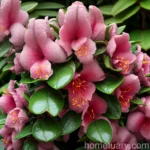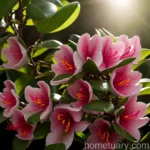Flame Azalea (Rhododendron calendulaceum)
Flame azalea, scientifically known as Rhododendron calendulaceum, is a captivating and vibrant native azalea species that is a favorite among plant enthusiasts and gardeners. Known for its stunning flame-like blossoms and fine foliage, this deciduous azalea variety adds a pop of color to gardens and landscapes, particularly in the Appalachian region of North America. In this comprehensive guide, we will delve into the culture, uses, care requirements, propagation, common diseases, pests, and botanist’s tips on the flame azalea.
Key Takeaways – Flame Azalea (Rhododendron calendulaceum)
Before we dive into the detailed discussion, let’s summarize some key takeaways about the flame azalea for quick reference:
- Flame Azalea Plant: A vibrant and showy native azalea species with flame-colored blossoms and fine foliage.
- Rhododendron calendulaceum: The scientific name of flame azalea, belonging to the Rhododendron family.
- Native Azalea Species: This plant is a wildflower of the mountains and is native to the Southeastern region of the United States, particularly the Appalachian mountains.
- Blooming Azalea Variety: Known for its spectacular springtime blooms, the flame azalea is a floriferous and eye-catching shrub.
- Water: It requires moderate watering, ensuring the soil stays consistently moist but not waterlogged.
- Sunlight: Prefers partial shade to full sun, thriving in dappled sunlight or morning sun with afternoon shade.
- Fertilizer: Requires a balanced, slow-release fertilizer for optimal growth and blooming.
- Soil: Thrives in well-draining, acidic to slightly acidic soil with good organic content.
- Pruning: Minimal pruning is needed, primarily for removing dead or damaged branches.
- Propagation: Can be propagated through seeds or softwood cuttings.
- Container Popularity: It is a popular choice for container gardening.
- Common Diseases: Susceptible to certain fungal diseases, including powdery mildew and leaf spot.
- Disease Diagnosis: Regular monitoring for signs of diseases is crucial for early diagnosis and treatment.
- Common Pests: May attract lace bugs, spider mites, and caterpillars.
- Botanist’s Tips: Ensure proper air circulation, maintain soil moisture, and provide adequate protection from harsh winds and extreme temperatures.
- Fun Facts: Known for its unique flower structure and striking hues, the flame azalea is a versatile and low-maintenance plant, attracting pollinators and wildlife to gardens.
These attributes make the flame azalea a delightful addition to gardens, offering a burst of color and botanical charm to outdoor spaces.
Culture of Flame Azalea
Understanding the cultural requirements of the flame azalea is essential for promoting its health, vigor, and prolific blooming. Let’s delve into its cultural needs to ensure that it thrives in garden settings.
Uses
The flame azalea serves several practical and aesthetic purposes in landscaping and horticulture. Some of the key uses include:
- Ornamental Plant: It is primarily cultivated for its stunning and showy blooms, adding aesthetic appeal to gardens, landscapes, and naturalistic settings.
- Wildlife Attraction: The vibrant flowers of the flame azalea attract various pollinators, including bees, butterflies, and hummingbirds, making it an excellent choice for wildlife-friendly gardens.
- Container Gardening: Its popularity in container gardening makes it an ideal choice for patio, balcony, or small-space gardens, providing a burst of color in compact settings.
- Borders and Hedges: Due to its tall-growing nature and attractive foliage, the flame azalea can be used as a striking border plant or in hedge arrangements, creating a vibrant and lush perimeter.
The multifaceted uses of the flame azalea showcase its versatility and beauty, making it a cherished addition to diverse garden designs.
Water
Proper watering is crucial for the health and growth of the flame azalea. While it is important to maintain consistently moist soil, overwatering should be avoided to prevent root rot and other water-related issues. Consider the following watering guidelines:
- Moderate Watering: Provide moderate and consistent moisture to the soil, particularly during dry spells and hot weather.
- Avoid Waterlogging: Ensure that the soil is well-draining and does not become waterlogged, as excessive moisture can lead to root rot and other diseases.
- Mulching: Apply a layer of organic mulch around the base of the plant to retain soil moisture and suppress weed growth, benefiting the overall health of the flame azalea.
By adhering to appropriate watering practices, gardeners can support the vigor and blooming of this captivating azalea variety.
Sunlight
The flame azalea thrives in locations with dappled sunlight or partial shade, making it well-suited for various garden settings. Here are some essential considerations regarding sunlight requirements:
- Partial Shade to Full Sun: While it prefers dappled sunlight, it can also tolerate full sun conditions, especially if the soil moisture is adequately maintained.
- Morning Sun with Afternoon Shade: Providing morning sun exposure followed by shade in the afternoon can contribute to optimal growth and blooming.
- Protection from Harsh Sun: During hot summer months, shelter the plant from intense sunlight to prevent sunburn and moisture loss.
Accommodating the flame azalea’s sunlight preferences ensures that it receives the ideal light conditions for healthy and vigorous growth.
Fertilizer
Fertilization plays a pivotal role in providing the necessary nutrients for the flame azalea to thrive and produce abundant blooms. While it is essential to feed the plant appropriately, it is equally important to avoid overfertilization, which can lead to adverse effects. Consider the following fertilization guidelines:
- Balanced Fertilizer: Apply a balanced, slow-release fertilizer formulated for acid-loving plants in the early spring, following the manufacturer’s recommendations for application rates.
- Avoid Excessive Nitrogen: Refrain from using fertilizers high in nitrogen, as excessive nitrogen can promote lush foliage growth at the expense of blooming.
- Fertilization Frequency: Depending on the soil fertility and plant requirements, a once-yearly application of fertilizer may suffice for some established flame azalea specimens.
By adopting a balanced approach to fertilization, gardeners can support the plant’s nutritional needs, promoting vigorous growth and vibrant blooms.
Soil
The soil composition significantly impacts the health and performance of the flame azalea, and it is crucial to provide an environment where it can thrive. Understanding the soil requirements is essential for successful cultivation. Consider the following soil guidelines:
- Well-Draining Soil: The flame azalea thrives in well-draining soil to prevent waterlogging and root rot. Amending heavy or compacted soil with organic matter improves drainage and aeration.
- Acidic to Slightly Acidic pH: It prefers soil with an acidic to slightly acidic pH range of 5.0 to 6.0, making it well-suited for cultivation in regions with naturally acidic soil or where the soil has been amended accordingly.
- Organic Content: Soil enriched with organic matter, such as compost or peat moss, provides essential nutrients and improves soil structure, benefiting the overall health of the plant.
Creating an optimal soil environment ensures that the flame azalea receives the necessary support for robust growth and prolific blooming.
Pruning, Propagation, and Container Popularity
Pruning, propagation, and the plant’s suitability for container gardening are essential aspects of the flame azalea’s care and cultivation. Let’s explore these factors in detail to gain a comprehensive understanding of the plant’s management and propagation techniques.
Pruning
Pruning is an integral part of maintaining the health and form of the flame azalea, and understanding the key considerations for pruning practices is essential. While this plant requires minimal pruning compared to other species, periodic maintenance is beneficial. Consider the following pruning guidelines:
- Deadheading Spent Blooms: Remove faded or spent blooms promptly to promote continuous blooming and prevent the formation of seed pods.
- Minimal Pruning of Branches: Limited pruning may be necessary to remove dead or damaged branches, enhancing the plant’s overall appearance and health.
- Pruning Timing: Ideally, prune the flame azalea right after the blooming period to avoid disrupting the next season’s flower buds.
By exercising care and precision in pruning practices, gardeners can ensure that the flame azalea maintains an attractive and healthy form throughout the growing seasons.
Propagation
The flame azalea can be propagated through various methods, including seeds and softwood cuttings. Understanding the propagation techniques enables gardeners to expand their plant collection and cultivate new specimens. Consider the following points related to propagation:
- Seed Propagation: Collect seeds from mature pods and sow them in well-prepared soil with adequate moisture. It may take some time for seed-grown specimens to reach blooming maturity.
- Softwood Cuttings: Take softwood cuttings in early summer and propagate them in a suitable rooting medium, providing the necessary warmth and moisture for successful rooting.
By incorporating propagation techniques, gardeners can propagate and cultivate new flame azalea plants, contributing to the conservation and promotion of this vibrant azalea species.
Container Popularity
The flame azalea’s popularity in container gardening makes it a versatile choice for various garden settings, including small urban spaces, patios, and balconies. Here are some essential considerations related to its suitability for container cultivation:
- Container Selection: Choose a spacious and well-draining container to accommodate the plant’s root system. Ensure that the container has drainage holes to prevent waterlogging.
- Potting Mix: Use a high-quality, acidic potting mix formulated for azaleas and other acid-loving plants, providing the necessary nutrients and soil structure for healthy growth.
- Watering and Maintenance: Regularly monitor the soil moisture and provide consistent watering to ensure that the plant’s needs are met. Additionally, consider repotting as needed to prevent root congestion.
By embracing container gardening, gardeners can showcase the beauty of the flame azalea in a versatile and compact manner, enhancing the appeal of outdoor living spaces.
Common Diseases, Pest Management, and Botanist’s Tips
As with any plant, the flame azalea is susceptible to certain diseases and pest infestations that can affect its health and vitality. Understanding common diseases and pests, along with implementing botanist’s tips, is essential for maintaining the plant’s well-being and resilience. Let’s explore these aspects in detail.
Common Diseases
Several fungal diseases can affect the flame azalea, and proactive monitoring and management are essential for preventing and addressing these issues. Some of the common diseases include:
- Powdery Mildew: This fungal disease presents as a powdery, white coating on the foliage and flowers, typically occurring in humid conditions. Adequate air circulation and fungicidal treatments can help manage powdery mildew.
- Leaf Spot: Leaf spot diseases manifest as dark spots or lesions on the foliage, leading to leaf discoloration and defoliation. Proper sanitation and fungicidal treatments can aid in controlling leaf spot.
Regular inspection of the plant for signs of fungal diseases and timely intervention are crucial for preserving its health and visual appeal.
Disease Diagnosis
Timely diagnosis of diseases is pivotal for implementing effective management strategies and preventing the spread of infections. Gardeners should be vigilant in identifying early signs of diseases and taking necessary steps to address them. Consider the following points related to disease diagnosis:
- Visual Inspection: Regularly examine the foliage, stems, and blooms for any signs of discoloration, lesions, or unusual growth patterns that may indicate disease presence.
- Professional Consultation: In cases of uncertainty regarding disease diagnosis and management, seek guidance from horticulturists, plant pathologists, or experienced gardeners for accurate assessment and treatment recommendations.
By proactively monitoring the plant and seeking professional advice when needed, gardeners can maintain the health and vigor of the flame azalea.
Common Pests
The flame azalea may attract certain pests that can compromise its vitality and blooming. Understanding common pests and implementing appropriate pest management measures is essential for safeguarding the plant. Some of the common pests include:
- Lace Bugs: These small, winged insects can cause stippling and discoloration on the foliage, affecting the overall appearance of the plant. Insecticidal treatments can help control lace bug infestations.
- Spider Mites: Spider mites are known for feeding on plant tissues, leading to stippling, webbing, and decline in plant health. Regular monitoring and horticultural oils can aid in managing spider mite infestations.
By monitoring for pest activity and adopting integrated pest management practices, gardeners can protect the flame azalea from potential pest damage.
Botanist’s Tips
To optimize the growth and blooming of the flame azalea, consider the following botanist’s tips that encompass essential care and management practices:
- Air Circulation: Ensure adequate air circulation around the plant to minimize the risk of fungal diseases and promote overall plant health.
- Soil Moisture Management: Maintain optimal soil moisture levels, balancing consistent moisture with well-draining conditions to prevent both water stress and waterlogging.
- Protection from Harsh Environmental Conditions: Provide shelter from strong winds, particularly in exposed locations, and protect the plant from extreme temperatures to minimize stress and damage.
Incorporating these botanist’s tips into the care regimen of the flame azalea supports its resilience and longevity, enhancing its performance in garden settings.
Fun Facts and Conclusion
Fun Facts
Before concluding our comprehensive guide, let’s explore some fun and intriguing facts about the flame azalea:
- Unique Flower Structure: The flame azalea is renowned for its flame-shaped petals and vivid colors, creating a spectacular visual display in gardens and natural landscapes.
- Attractiveness to Pollinators: The vibrant blooms of the flame azalea act as a magnet for various pollinators, enhancing biodiversity and ecological balance within garden ecosystems.
- Drought Tolerance: Despite its preference for moist soil, the flame azalea exhibits a degree of drought tolerance, making it a resilient and adaptable plant in varying environmental conditions.
These fun facts underscore the fascinating attributes and ecological significance of the flame azalea, reinforcing its appeal as a versatile ornamental plant for gardens and landscapes.
Conclusion
In conclusion, the flame azalea (Rhododendron calendulaceum) stands as a captivating and vibrant specimen, showcasing its unique beauty and ecological value. Its striking blooms, fine foliage, and adaptable nature make it a popular choice for gardeners and landscaping enthusiasts. By understanding its cultural needs, propagation techniques, pest management, and botanist’s tips, individuals can cultivate and enjoy the charm of this native azalea species.
Embracing the colorful springtime blooms, botanical charm, and low-maintenance appeal of the flame azalea adds a touch of natural splendor to gardens, enriching outdoor spaces and fostering a deeper connection with the enchanting world of plants.
Links to External Resources:
1. Flame Azalea: USDA Plant Guide
2. Growing Azaleas and Rhododendrons
3. Azalea Care and Culture
4. Controlling Pests and Diseases of Azaleas
In this blog post, we’ve explored the captivating and vibrant attributes of the flame azalea, shedding light on its cultural needs, propagation, pest management, and fun facts. By celebrating the botanical charm and ecological significance of this native azalea species, we appreciate the natural beauty and diversity of plant life within garden landscapes and outdoor environments.
Remember, the flame azalea’s resilience and showy nature make it a standout addition to gardens, enriching the surroundings with its vibrant blossoms and fine foliage. Embrace the allure of this stunning azalea variety and witness its transformative impact on garden spaces, creating a tapestry of color and botanical vitality.
So, whether you are an avid gardener, landscaping enthusiast, or nature lover, the flame azalea has much to offer, captivating hearts and minds with its flamboyant display of botanical splendor. Cultivate its beauty, cherish its ecological value, and savor the enchanting presence of this charismatic native azalea species.
Flame azalea: A botanical treasure, a symphony of colors, and a beacon of natural splendor in the gardens of life.















